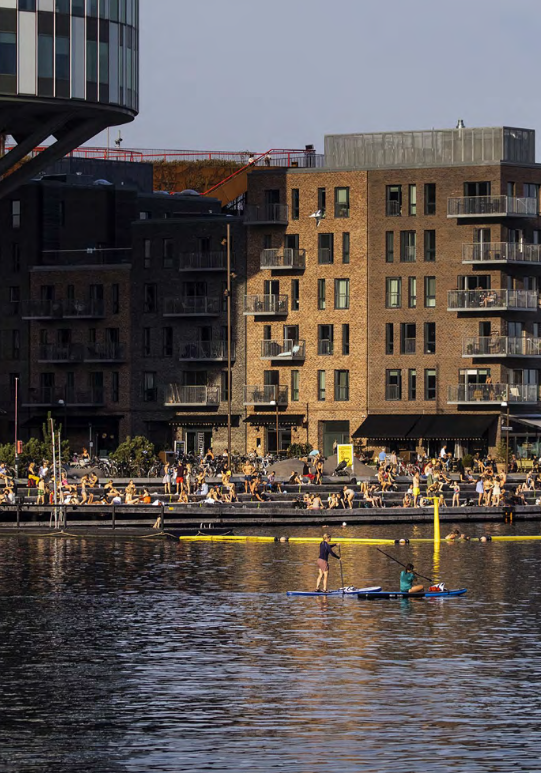Discover how Copenhagen’s harbor became a model of social sustainability, blending urban life, nature, and governance.
Image: By & Havn
While the EU continues to debate the boundaries of ESG (Environment, Social, Governance) with some advocating that defense and security spending could be included within, the Port of Copenhagen provides a compelling illustration of how the “S” can be anchored in practice, with tangible meaning.
At the recent Connected River partner meeting in Vordingborg, Johannes and Anne from By & Havn shared how the Social dimension is being embedded in the harbor’s transformation: from a historically industrial and polluted port into a mixed-use waterfront that now accommodates commerce, recreation, and everyday life.

© By & Havn
Only a decade ago, the water in Copenhagen’s harbor was considered heavily polluted: a toxic legacy of its industrial past. Today, through political will and deliberate urban planning, it has become a flagship of urban–nature integration, with floating saunas, kayaking routes, and even Red Bull events woven into the cityscape. Yet greater accessibility also brings governance challenges: NATO cargo ships, canal boats, swimmers, kayakers, tourists, and late-night partygoers must coexist in the same space. This tension has produced a governance model that is at once strict and sensitive, combining firm regulation with active citizen participation. From this case, four lessons emerged, which we summarise as Match, Make, Measure, Mobilize below:
1. Match the method to the moment
Lesson: Engagement isn’t one-size-fits-all.
Do: Decide early: do we co-design (e.g., a new swimming area), broadly consult (e.g., noise rules), or make a firm top-down call (e.g., navigation safety) depending on the stakeholders and the task at hand. The art (and perhaps the science) lies in knowing which approach fits which issue.
2. Make meaning from disruption
Lesson: A burning platform can push actors into accountability, but we don’t need to wait for another one.
Do: Set up systems that mimic learnings from previous crises. Create feedback loops, e.g., citizen hotlines for unsafe behavior, or protocols for responding to violations, so responsibility is built in before a crisis strikes.
3. Measure what matters
Lesson: Evidence turns good intentions into smart action. Copenhagen found that younger men and women, unlike middle-aged men in other geographies, were most at risk, to which they tailored their campaigns.
Do: Gather local data (incident reports, surveys) and adjust campaigns to fit your actual community, not generic assumptions.
4. Mobilize through dialogue
Lesson: People engage when they see themselves reflected in outcomes.
Do: Start conversations from what unites (love of place, safety for children), not what divides. Then follow through with visible, concrete changes, that they understand, and give them a bite of it. For e.g., even small ones like moving a bench a meter for safety or installing clearer signage.
Two years into the Connected River project, after a series of experiments, some successful, others more like springboards (yes, that was a Nijmegen bridge-jumping reference), we are now consolidating our learnings. As part of this effort, we are in the process of building a book that shares case studies and practical guidance on how waterfronts and waterways can be transformed for societal good. Stay tuned: it will be both a reflection of the past years and a guidebook for the journeys still ahead.
Find out more abut the Port Economics & Business Master Class at Antwerp Management School (AMS) >>
Source: AMS
About AMS and their role within Connected River
AMS is Work Package 1 (WP1) leader and will facilitate and coordinate the ecosystem development efforts by the Host Partners. In Work Package 2, AMS will co-design the business design thinking methodologies to develop agile, user-centred innovations in a multistakeholder, mixed use waterway and waterfront ecosystem. It will also facilitate the alignment between WP1 ecosystem methodologies and WP2 innovation methodologies and act as evaluator and soundboard regarding the implementation of the host partners’ ecosystem and innovation projects.
